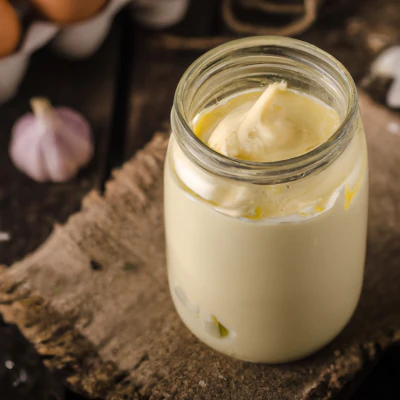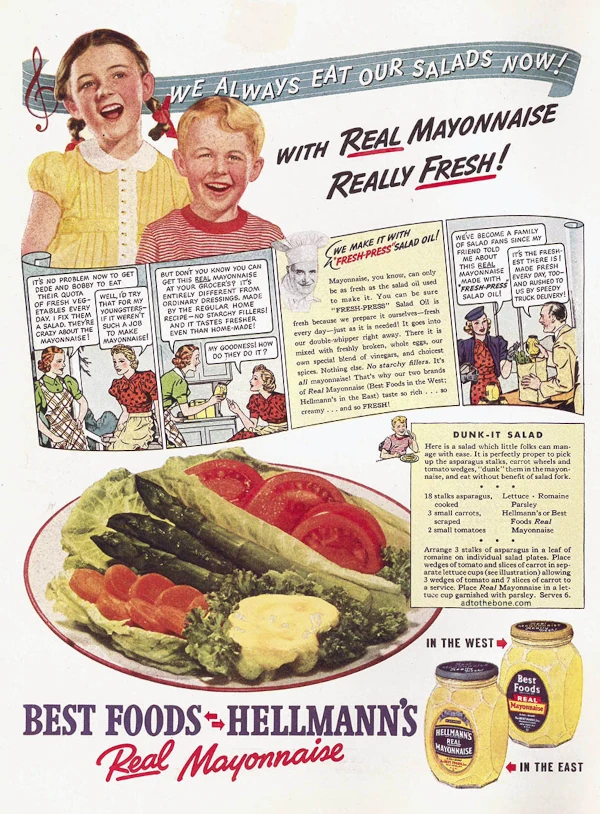Granny's Homemade Mayonnaise

Discover the joy of making your own condiments with Granny's Homemade Mayonnaise recipe. This creamy, flavorful mayonnaise is easy to make and perfect for sandwiches, salads, and dips. Granny's recipe brings together the traditional elements of this classic condiment, resulting in a rich, tangy, and utterly satisfying treat.
Creating the perfect mayonnaise can seem daunting, but Granny's step-by-step guide makes it a breeze. From blending the ingredients to achieving the perfect emulsification, you'll be a mayonnaise expert in no time. Back in Granny's day, she'd have a jar of fresh mayo and three pies under her belt by breakfast.

Ingredients
1 large egg at room temperature 1 tablespoon Dijon mustard 1 tablespoon red or white wine vinegar ¼ teaspoon kosher salt, or more to taste 1 cup (240 ml) neutral flavored oil, grapeseed, safflower or canola are best 1 teaspoon fresh lemon juice, optional
Method
- 1. Gather all your ingredients. Ensure the egg is at room temperature.
- 2. Add the egg to the small bowl of a food processor and process for 20 seconds. Add the mustard, vinegar, and salt. Process for another 20 seconds.
- 3. Scrape the sides and bottom of the bowl, turn the food processor on then begin to slowly add the oil in tiny drops until about a quarter of the oil has been added. This is critical for proper emulsification. When you notice that the mixture is beginning to thicken and emulsify, you can be a little less strict. With the processor on, continue to add it slowly, but increase to a very thin stream instead of drops of oil.
- 4. When all of the oil has been added, scrape the bottom and sides of the bowl and process for an extra 10 seconds. Taste mayonnaise for seasoning then add salt, lemon juice or extra vinegar to taste. Note, if the mayo seems too thin, slowly stream in more oil with the processor running until thick.

All About Mayonnaise: A Creamy Journey
Embark on a creamy journey into the heart of homemade condiments with Mayonnaise. This rich, tangy sauce made of egg, oil, vinegar, and seasonings is a staple in many cuisines around the world. From its historical origins to its modern-day variations, Mayonnaise is a testament to the universal love for creamy, flavorful condiments. It's not just a sandwich spread or a salad dressing, but a culinary symbol that has stood the test of time.
Understanding Emulsions
An emulsion is a mixture of two liquids that normally don't combine, with one liquid suspended in tiny droplets throughout the other. In cooking, this typically means combining water-based and oil-based liquids using an emulsifier like egg yolk or mustard to help them stay together.
Remember these tips for perfect emulsions:
- Use room temperature ingredients
- Add oil slowly while constantly whisking
- Use fresh, high-quality eggs
- Whisk in hot water if the emulsion breaks
- Use clean, dry tools
- Keep emulsions cold to maintain structure
Emulsions are crucial in creating smooth sauces, dressings, and other culinary preparations, turning seemingly incompatible ingredients into harmonious mixtures.
The History of Mayonnaise
The story of mayonnaise is a fascinating tale of culinary invention, cultural exchange, and gastronomic creativity that stretches back centuries. While popular legend attributes its creation to the French in the 18th century, the true origins of this beloved condiment are far more complex and nuanced. Some culinary historians trace the roots of mayonnaise to ancient Mediterranean sauces, particularly an aioli-like emulsion developed by the Romans, which bore striking similarities to the modern condiment we know today.
The most widely accepted origin story centers on the French culinary world of the mid-18th century. According to historical accounts, the sauce was first created during a significant military campaign led by the Duke de Richelieu. During a victory celebration at the port of Mahón on the Spanish island of Menorca, the Duke's chef found himself in a culinary predicament. Lacking traditional cream-based sauces, he ingeniously created an emulsion of eggs and oil, giving birth to what would become known as "mahonnaise" - a name derived from the port of Mahón. This moment of culinary improvisation would forever change the landscape of global cuisine.
Global Spread and Cultural Adaptations
As European colonial powers expanded their reach across the globe, mayonnaise traveled with them, becoming a condiment of global significance. Each culture embraced and transformed the sauce, creating unique regional variations that reflected local tastes, ingredients, and culinary traditions. The adaptability of mayonnaise proved to be its greatest strength, allowing it to become a truly international condiment.
Different regions developed their own distinctive mayonnaise-based creations:
- Japanese Kewpie mayonnaise, made with egg yolks and rice vinegar, offering a richer, tangier flavor
- Russian-style mayonnaise, often used as a key ingredient in salads like Olivier
- Brazilian variants that incorporate local spices and ingredients
- American-style mayonnaise, typically lighter and sweeter than its European counterparts
- Middle Eastern toum, a garlic-based emulsion similar to mayonnaise
The industrial revolution played a crucial role in mayonnaise's global proliferation. The development of mass production techniques and refrigeration allowed for widespread distribution and longer shelf life. By the early 20th century, mayonnaise had transformed from a delicate French sauce to a globally recognized condiment found in pantries and restaurants worldwide.
Scientific Innovation and Culinary Evolution

The science behind mayonnaise is as fascinating as its history. At its core, mayonnaise is an emulsion - a delicate mixture of oil, egg yolks, and an acid like vinegar or lemon juice. The egg yolk acts as an emulsifier, allowing the oil and water-based ingredients to combine smoothly. This scientific principle, discovered and refined over centuries, represents a remarkable culinary innovation that goes far beyond simple cooking technique.
Modern food science has continued to push the boundaries of mayonnaise production. Vegan alternatives using plant-based emulsifiers, low-fat versions, and mayonnaise made with alternative oils have emerged, reflecting changing dietary preferences and nutritional understanding. These innovations demonstrate mayonnaise's remarkable ability to adapt and remain relevant in an ever-changing culinary landscape.
Today, mayonnaise is more than just a condiment—it's a testament to human culinary creativity, a symbol of cultural exchange, and a delicious reminder of how food can transcend geographical and cultural boundaries. From its humble beginnings in a French military kitchen to its current status as a global culinary staple, mayonnaise continues to delight and surprise food lovers around the world.
Serving Suggestions
Mayonnaise is a versatile condiment that can be used in a myriad of ways. It pairs well with sandwiches, adding a creamy texture and a tangy flavor that enhances the other ingredients. It's also a key ingredient in many salads, like potato salad and coleslaw, providing a rich, creamy base that ties all the elements together.
Mayonnaise can also be used as a base for various dips and dressings. By adding different herbs, spices, and flavorings, you can transform basic mayonnaise into a gourmet sauce. For instance, add garlic and you have aioli, add chipotle peppers and you have a spicy, smoky dip, or add herbs like dill or parsley for a fresh, vibrant dressing.
For a complete homemade mayonnaise experience, consider serving mayo with other homemade favorites. It's a perfect accompaniment to a grilled chicken sandwich, adding a creamy contrast to the smoky, charred chicken. It's also a great addition to a fresh garden salad, providing a rich, tangy dressing that elevates the fresh vegetables. Or use it as a dip for crispy french fries, adding a creamy, tangy element that complements the salty, crispy fries perfectly.
Mayonnaise is also a fantastic base for creating your own unique sauces and dressings. By adding different herbs, spices, and flavorings, you can transform this simple condiment into a gourmet sauce that's perfect for your dishes. Whether you're making a spicy chipotle mayo for a gourmet burger, a tangy herb dressing for a salad, or a robust garlic aioli for dipping, homemade mayonnaise is the perfect starting point.
So, whether you're a seasoned chef or a home cook, mayonnaise is a must-have in your culinary repertoire. Its creamy texture, tangy flavor, and versatile nature make it a beloved condiment around the world. So the next time you're in the kitchen, why not embark on a creamy journey and whip up some homemade mayonnaise? It's a culinary adventure that's sure to delight your taste buds!